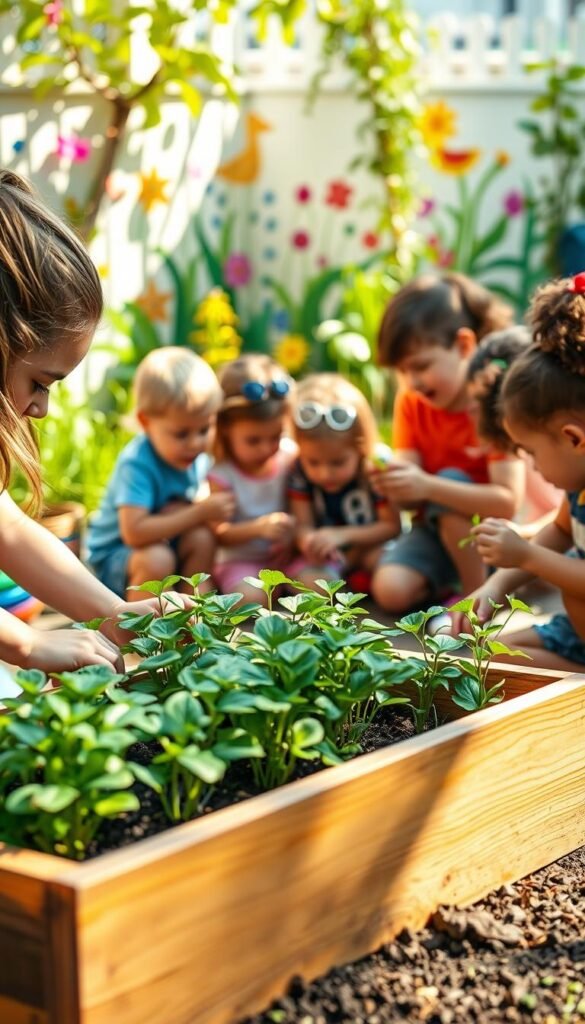Looking for a playful way to boost your little one’s coordination while sparking their curiosity? Digging into nature-based projects offers a perfect mix of creativity and skill-building. Whether it’s scooping soil or arranging seeds, these hands-on tasks help young learners strengthen their grip, precision, and hand-eye control.
This guide will walk you through simple, engaging ideas that blend indoor and outdoor fun. From sensory play with textured materials to seasonal crafts that celebrate growth, every activity is designed to keep tiny hands busy and minds curious. You’ll also discover how nurturing plants teaches responsibility and patience in a way that feels like play.
Spring is an ideal time to start, but these projects work year-round. Think colorful seed mosaics, DIY watering stations, or even “mini garden” setups using recycled containers. Each task encourages children to practice pinching, pouring, and twisting—key steps for developing fine motor abilities.
Ready to explore? Let’s uncover how combining dirt, imagination, and gentle guidance can help your child bloom!
Why Gardening is a Great Way to Build Fine Motor Skills

Ever notice how kids naturally gravitate toward dirt and textures? Those messy moments are golden chances to grow coordination. Simple tasks like scooping soil or placing seeds teach control while feeling like play. Tiny fingers learn to grip, twist, and pinch—all essential for writing, buttoning shirts, and other daily wins.
Connecting Eyes and Hands Through Practice
Digging precise holes for seedlings isn’t just fun—it’s a stealth workout. Guiding a trowel to the right spot builds spatial awareness. Sprinkling water without flooding plants? That’s focus meeting finesse. Start with quick projects: try basil seeds in egg cartons. Success here means better pencil control later!
Powering Up Those Finger Muscles
Crumbling dry leaves or squeezing spray bottles strengthens hands quietly. Child-sized tools make it easier to practice pouring and raking. Twist herb stems during harvests or press flower petals into clay—these actions prep fingers for scissors and zippers. Celebrate progress, whether they’re planting radishes or arranging pebble paths!
Mix in stories about growing food or measuring rain. This blends movement with learning, keeping energy high. Remember: every seed planted is a step toward confident, capable hands.
Engaging Preschoolers with Sensory Garden Experiences

Have you ever watched a child’s eyes light up as they squish mud between their fingers? Multi-sensory exploration turns ordinary moments into brain-building adventures. Gardens become classrooms where textures, smells, and colors spark curiosity while quietly strengthening fine motor skills.
Interactive Garden-Themed Activities
Try play dough mats shaped like leaves or flowers. Kids roll, press, and mold while mimicking real plants. Add tools like plastic knives for “pruning” edges—this builds finger strength and precision. For group fun, create a living alphabet by arranging twigs or pebbles into letters.
Sensory Bins and Outdoor Exploration
Fill bins with dried black beans, mini pots, and silk flowers. Tweezers let little hands practice grabbing “seeds,” while scooping beans improves wrist control. Research shows that mixing textures engages multiple sensory systems at once.
| Material | Skill Practiced | Engagement Level |
|---|---|---|
| Dried Beans | Pinching, Pouring | High |
| Play Dough | Hand Strength | Medium-High |
| Silk Flowers | Twisting, Sorting | Medium |
Take exploration outdoors! Hide smooth stones or pinecones in soil for a texture scavenger hunt. Encourage kids to describe smells of herbs or crunch fallen leaves. These moments blend motor activities with joyful discovery.
Gardening Activities for Preschoolers: Building Fine Motor Skills

Tiny hands thrive when practice feels like play. Simple exercises disguised as games prepare young learners for writing while keeping energy high. Start with garden-themed pencil paths—wavy lines shaped like vines or zig-zag “fence” patterns.
Fun Pre-Writing and Pencil Path Exercises
Laminate sheets with curvy carrot tops or looping flower stems. Kids trace these paths using chubby crayons or dry-erase markers. Mix it up! Try finger-painting lines with mud (outdoors) or glitter glue (indoors). This builds steady hand control needed for letter formation.
Seed Transfer and Snap Cube Projects
Place sunflower seeds in an egg carton with kitchen tongs. Counting while moving them strengthens pincer grasp and math skills. Snap cubes take it further—challenge children to build 3D “plants” following picture cards. These projects boost both fine motor abilities and spatial reasoning.
Use colorful trays to keep materials organized. Rotate activities weekly to maintain excitement. With each seed sorted or cube connected, little fingers grow more confident and capable!
Creative Projects to Enhance Fine Motor Skills in the Garden

Transform garden time into skill-building art sessions with crafts that blend creativity and coordination. These projects turn ordinary materials into tools for strengthening little hands while sparking joy in nature’s details.
DIY Garden Markers and Flower Tracing
Let kids design plant labels using smooth stones or popsicle sticks. Drawing flowers or vegetables with markers builds grip strength. Pair this with tracing templates—cut leaf shapes from cardboard, then outline them with crayons. Repeated tracing refines hand control needed for writing.
Play Dough Mats and Pipe Cleaner Crafts
Roll dough into carrot shapes or press petals onto textured mats. Twisting pipe cleaners into spiral stems or sunflower centers challenges finger dexterity. These tactile tasks quietly boost fine motor development through playful repetition.
Incorporating Nature’s Colors
Sort autumn leaves by hue or arrange flower petals into rainbow collages. Scissor practice comes naturally when cutting magazine images of gardens. Matching colors while handling small items sharpens both visual skills and precision.
Whether arranging pebble mosaics or threading beads onto stems, these ideas merge artistry with coordination practice. Every snip, twist, and pinch brings young learners closer to confident hand movements!
Outdoor and Indoor Gardening Ideas for Every Season

Who says garden adventures stop when temperatures drop? With smart planning, young learners can nurture plants year-round while refining hand control and coordination. These adaptable projects keep little hands busy whether you’re dodging rain showers or enjoying sunny days.
Winter Seed Planting and Early Garden Prep
Transform windowsills into mini nurseries during colder months. Start tomato or pumpkin seeds in egg cartons—their small compartments help children practice precise pouring. Sprouting basil or wildflowers indoors teaches patience as kids track growth weekly. Use lightweight watering cans to build wrist strength without spills.
Seasonal Adjustments for Planting and Weeding
Swap outdoor beds for container gardens when frost arrives. Let kids arrange pebbles in drainage layers or sort seeds by size. In spring, introduce child-sized rakes for gentle soil turning. Summer’s warmth? Perfect for transferring seedlings using tongs to boost grip power.
| Season | Activity | Skills Practiced |
|---|---|---|
| Winter | Indoor herb planting | Pinching, Pouring |
| Spring | Seedling transfers | Hand-Eye Coordination |
| Summer | Vegetable harvesting | Twisting, Cutting |
| Fall | Leaf sorting | Sorting, Gripping |
Adjust tools and tasks to match weather conditions. Foam mats make indoor potting mess-free, while oversized seeds like sunflowers simplify outdoor planting. These adaptations ensure steady progress in motor development, rain or shine!
Practical Tips to Make Gardening More Fun and Educational

Want to turn garden time into a skill-building playground? Small adjustments can transform routine tasks into adventures that nurture both fine motor development and curiosity. Let’s explore how to set up success with tools and techniques designed for little learners.
Using Child-Sized Tools for Enhanced Grip
Mini shovels and lightweight watering cans let young hands practice pouring and digging without strain. Look for tools with textured handles—they improve grip while teaching proper wrist angles. A small rake helps scoop leaves, building forearm strength through repetitive motions.
Involving Movement and Literacy in Gardening
Act out seed sprouting with arm stretches or wiggle like worms after planting. Pair physical breaks with printable plant cards showing actions like “water” or “dig.” Label pots together using stickers, blending letter recognition with coordination practice.
| Tool Type | Skill Boosted | Engagement Tip |
|---|---|---|
| Mini Trowel | Wrist Rotation | Dig “treasure holes” for marbles |
| Spray Bottle | Finger Squeeze | Watercolor misting on rocks |
| Seed Scoop | Pinch Precision | Sort beans by color first |
Schedule short, frequent sessions to maintain interest. Celebrate tiny wins—like threading stems through trellises—to build confidence. These strategies turn motor skill growth into joyful milestones!
Wrapping Up Your Garden Adventures for Skill Building
Every pinch of soil and splash of water holds more than just fun—it’s a stepping stone to confident little hands. Through seed transfers, pebble sorting, and playful planting, young learners strengthen their coordination while connecting with nature’s rhythms. Whether indoors with recycled pots or outdoors in spring sunshine, these moments build finger strength and focus organically.
Remember the joy of arranging flower petals or tracing leaf shapes? Those creative projects aren’t just art—they’re stealthy practice for future writing skills. And when you adapt tasks like planning a square-foot garden, you blend math and spatial reasoning into hands-on exploration.
Keep activities fresh by rotating materials seasonally. Try dried beans for pouring drills in winter or fresh herbs for summer scent games. Each adaptation keeps tiny fingers challenged and engaged. Celebrate progress, whether it’s a steady grip on watering cans or precise seed placement.
Ready to dig deeper? Start small with a windowsill herb setup or a textured scavenger hunt. Every scoop, twist, and pinch nurtures both plants and growing minds. With simple tools and endless curiosity, your child’s next garden adventure could bloom into lifelong skills—and maybe even a love for nurturing green spaces!






